
Lake Tanganyika is an African Great Lake. It is the second-oldest freshwater lake in the world, the second-largest by volume, and the second-deepest, in all cases after Lake Baikal in Siberia. It is the world's longest freshwater lake. The lake is shared among four countries—Tanzania, the Democratic Republic of the Congo (DRC), Burundi, and Zambia, with Tanzania (46%) and DRC (40%) possessing the majority of the lake. It drains into the Congo River system and ultimately into the Atlantic Ocean.
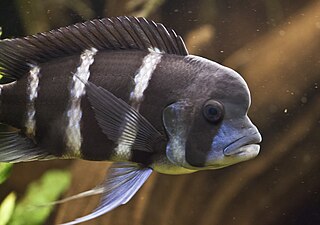
Cyphotilapia frontosa, also called the front cichlid and frontosa, is an east African species of fish endemic to Lake Tanganyika. The genus name is a combination of the Ancient Greek "cypho-", meaning "curved", and tilapia, which means "fish" in a local dialect. The species name frontosa is a reference to its relatively large forehead.

Neolamprologus is a genus of cichlids endemic to eastern Africa with all but one species, Neolamprologus devosi from the Malagarasi River, occurring in Lake Tanganyika. It is the largest genus of cichlids in Lake Tanganyika and also the largest genus in the tribe Lamprologini, which includes Altolamprologus, Chalinochromis, Julidochromis, Lamprologus, Lepidiolamprologus, Telmatochromis and Variabilichromis. The latter is a monotypic genus doubtfully distinct from Neolamprologus.
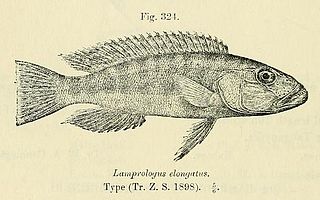
Lepidiolamprologus is a small genus of cichlids endemic to Lake Tanganyika in eastern Africa. It is closely related to Altolamprologus. and there is the possibility that a revision of the genus could see more species added.
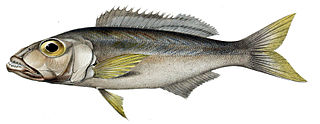
Bathybates is a genus of piscivorous cichlids endemic to Lake Tanganyika in East Africa. The genus includes both pelagic species that mainly feed on Tanganyika sardines and benthic species that mainly feed on other cichlids. They are some of the deepest-living cichlids, regularly occurring down to 200 m (660 ft).

The haplochromine cichlids are a tribe of cichlids in subfamily Pseudocrenilabrinae called Haplochromini. This group includes the type genus (Haplochromis) plus a number of closely related genera such as Aulonocara, Astatotilapia, and Chilotilapia. They are endemic to eastern, southern and northern Africa, except for Astatotilapia flaviijosephi in the Middle East. A common name in a scientific context is East African cichlids – while they are not restricted to that region, they are the dominant Cichlidae there. This tribe was extensively studied by Ethelwynn Trewavas, who made major reviews in 1935 and 1989, at the beginning and at the end of her career in ichthyology. Even today, numerous new species are being described each year.
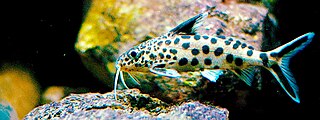
Synodontis multipunctatus, also known as the cuckoo catfish, cuckoo squeaker, or multipunk, is a small catfish from Lake Tanganyika, one of the lakes in the Great Rift Valley system in Africa. It is a brood parasite upon mouthbrooding cichlids. This species grows to a length of 27.5 centimetres (10.8 in) TL. This species is a minor component of local commercial fisheries.

Rhamphochromis is a genus of East African haplochromine cichlids endemic to the Lake Malawi basin, also including Lake Malombe, Lake Chilingali, Chia Lagoon and upper Shire River. They mainly occur in offshore open waters, but a few species also near the coast. They are piscivores that typically feed on lake sardines and small utaka cichlids.
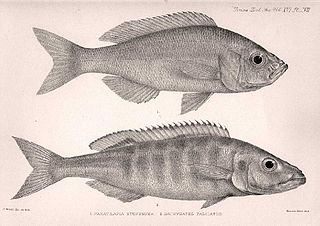
Hemibates stenosoma is a species of cichlid endemic to Lake Tanganyika in East Africa. It is generally most numerous at depths between 80 and 200 m (260–660 ft), but performs a seasonal migration to inshore regions when it can occur as shallow as 20 m (65 ft). It is predatory, feeding on fish and prawns, and grows to a total length of 30 cm (1 ft). This species was formerly regarded as the only formally described member of its genus., however, another species, Hemibates koningsi, which was formerly referred to as Hemibates sp. "stenosoma chituta" before its formal description.
Adrianus Franciscus Johannes Marinus Maria "Ad" Konings is an ichthyologist originally trained in medicine and biology. Konings is best known for his research on African rift lake cichlids. After studies in Amsterdam, he has spent most of his life in Rotterdam.

The giant cichlid, also known as the emperor cichlid, is a species of fish in the family Cichlidae, endemic to Lake Tanganyika in Africa. It is the only member of its genus Boulengerochromis and tribe Boulengerochromini.
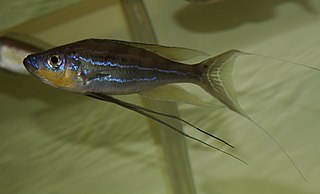
Benthochromis tricoti is a species of fish in the cichlid family. It is endemic to Lake Tanganyika in Africa and lives at depths of up to 100 m (330 ft). It feeds on small crustaceans and plankton. It reaches a maximum length of 16.5 cm (6.5 in). Like many other cichlids, it is a mouthbrooder.
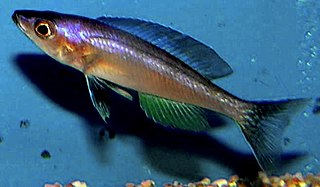
Cyprichromis leptosoma is a mouthbrooding species of fish in the family Cichlidae. It is endemic to Lake Tanganyika in Zambia and Tanzania. It seems quite common within its range and faces no particular threats, so the International Union for Conservation of Nature has assessed its conservation status as being of least concern.
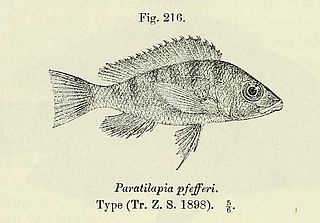
Gnathochromis pfefferi is an African species of fish in the family Cichlidae. It is endemic to Lake Tanganyika and its slow-flowing tributaries in the countries of Burundi, the Democratic Republic of the Congo, Tanzania and Zambia. It is common and widespread. This cichlid is found in relatively shallow waters, typically over soft bottoms in places with aquatic grasses.

The spotfin goby cichlid is an African species of cichlid endemic to Lake Tanganyika where it is only known from the northern end of the lake. They live amongst pebbles in the surf-zone. This species can reach a length of 7 centimetres (2.8 in) TL. This species can also be found in the aquarium trade. Although presently considered the only species in the genus, another undescribed species is known from the Lukuga River.

The Pseudocrenilabrinae are a subfamily in the cichlid family of fishes to which, according to a study from 2004, includes all the Middle Eastern and African cichlids with the exception of the unusual Heterochromis multidens and the Malagasy species. This subfamily includes more than 1,100 species. Previous authors recognized additional African subfamilies, e.g. the Tilapiinae of Hoedeman (1947), Tylochrominae of Poll (1986), or Boulengerochrominae of Tawil (2001).

Lamprologini is a tribe of African cichlid fishes. It contains seven genera and nearly 100 species. Over half of the species in this tribe are in the large genus Neolamprologus. Most genera in the tribe are endemic to Lake Tanganyika, but one species of Neolamprologus is from the Malagarasi River in Tanzania, and several species of Lamprologus are from the Congo River Basin.

Bathybatini is a tribe of cichlids endemic to Lake Tanganyika in Africa. They are mostly found in relatively deep waters and mainly feed on fish or plankton (Trematocara). They are mouthbrooders.

Cichlidogyrus is a genus of monopisthocotylean monogeneans in the family Ancyrocephalidae. The type-species of the genus is Cichlidogyrus arthracanthusPaperna, 1960, by original designation. All the species of the genus are parasites on the gills of fish, namely African Cichlidae, Nandidae and Cyprinodontidae.
Aulonocara koningsi is a species of haplochromine cichlid which is endemic to Lake Malawi. It is restricted to the waters around Mbenji Island and is therefore endemic to Malawi too. It is common in the restricted area in which it occurs but collection for the aquarium trade does not seem to have affected the population.
















